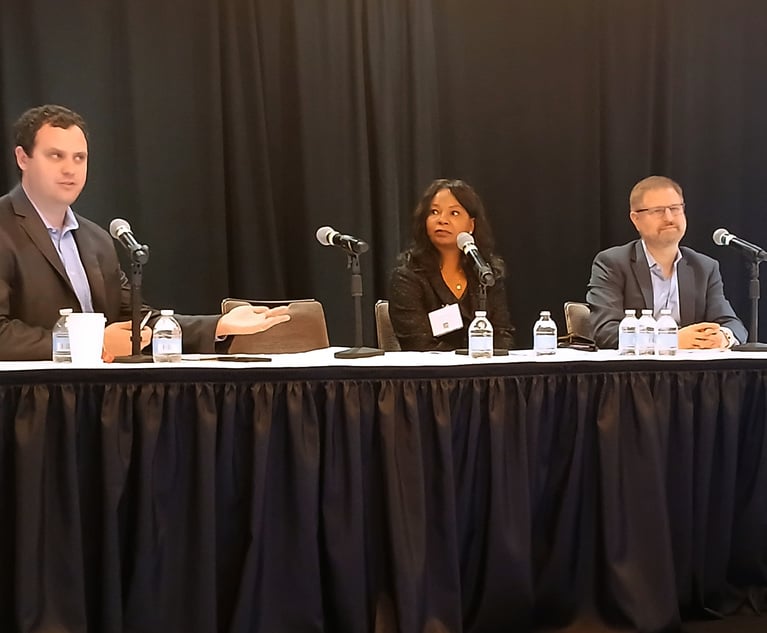
Series on Contracting Challenges: Let's Talk Tech
No discussion on contract process improvements is complete without a focus on technology; it is an essential facet of CLM. But the problem with technology is that automating a bad process only makes the bad process faster, but it is still bad. The trick is to identify the best technology for the organization.
October 04, 2021 at 03:51 PM
5 minute read
No discussion on contract process improvements is complete without a focus on technology; it is an essential facet of CLM. But the problem with technology is that automating a bad process only makes the bad process faster, but it is still bad.
The trick is to identify the best technology for the organization. But, as usual, it's complicated because the landscape is constantly changing.
Consider these points:
|- Technology is at the core of any discussion about innovation, but it should not be. Before any conversation about technology takes place, there should be an assessment of the current state of the people and processes involved in contracting. (See my previous articles on people and process.)
- Consider who should be part of the initial conversation. Start internally with key stakeholders to understand what they need from a technology solution. Understanding these needs is the most important part of any technology implementation.
- Start with taxonomy. Contract Lifecycle Management (CLM) is a function. It is not a system, although some, including much of the legal press refers to CLM as a system. This only confuses people. Some people even think that you can buy CLM, but what they're really trying to buy is a CMS: a contract management system or CLM system. Taxonomy becomes important when you're shopping for these things.
- Contracting is a lifecycle, and many contracts means many lifecycles; it is a combination of many processes, a series of activities and events, some of which are enabled with different types of technologies along the way. Other times, there's a goal to enable and manage the entire lifecycle through a single technology.
- Technology is particularly important in one area: The best way to gather data insights is through automation.
- Fully understand exactly what the organization intends to enable. For example, is it trying to enable better intake so that when the request comes in from the business contact, it has some basic information in it, and the number of these are tracked as they come in? If that is the case, create an intake form for business requestors to fill in. It is possible to create those forms in some of the technologies that the organization is likely already using, such as the Microsoft Office 365, or Google Forms. It doesn't necessarily have to be a formal or complex CMS to accommodate this particular need.
- Storage is at the other end of the CLM lifecycle. Many legal departments seek help to find the right contract management system and then realize that the one problem they're really trying to tackle is storage. They don't have a contract repository and they don't have an easy way to search for contracts. Contract management systems are designed for that, but starting first by creating a simple SharePoint site can be an effective first step. Many legal departments already have access to SharePoint and can start with something simple.
- Do you need an end-to-end technology solution? Some offer everything, from the request and the intake, all the way through to post-signature obligation tracking. Just note that they can't be good at every phase of this lifecycle, and they usually have strengths in some functions more than in others.
- There are lighter versions of end-to-end lifecycle systems. Those are excellent for smaller, more agile departments. These lighter systems are easier to implement and are software as a service (SaaS) cloud-based systems. They are the most agile systems, they're faster to implement, and they have some pretty good features along the entire lifecycle, though not as robust as more elaborate systems. One area of CLM-related technology that has been around for some time is document assembly. Document assembly is very useful when there is a solid clause library which can be used to create templates. The system basically relies on a decision tree that a company can design to help ask the right questions, and then produces the clauses that are relevant based on the answers received.
There's been a significant, and unprecedented, increase in investment and legal tech over the last few years, and contracting seems to be the top area of focus right now. In fact, the 2021 ACC Chief Legal Officers Survey reported that among CLOs who plan on adopting new legal technology over the next year, the vast majority (67%) claim they will specifically invest in contract management solutions.
This content has been archived. It is available through our partners, LexisNexis® and Bloomberg Law.
To view this content, please continue to their sites.
Not a Lexis Subscriber?
Subscribe Now
Not a Bloomberg Law Subscriber?
Subscribe Now
NOT FOR REPRINT
© 2024 ALM Global, LLC, All Rights Reserved. Request academic re-use from www.copyright.com. All other uses, submit a request to [email protected]. For more information visit Asset & Logo Licensing.
You Might Like
View All
Lawyers Drowning in Cases Are Embracing AI Fastest—and Say It's Yielding Better Outcomes for Clients

GC Conference Takeaways: Picking AI Vendors 'a Bit of a Crap Shoot,' Beware of Internal Investigation 'Scope Creep'
8 minute read
Why ACLU's New Legal Director Says It's a 'Good Time to Take the Reins'
Trending Stories
- 1'Largest Retail Data Breach in History'? Hot Topic and Affiliated Brands Sued for Alleged Failure to Prevent Data Breach Linked to Snowflake Software
- 2Former President of New York State Bar, and the New York Bar Foundation, Dies As He Entered 70th Year as Attorney
- 3Legal Advocates in Uproar Upon Release of Footage Showing CO's Beat Black Inmate Before His Death
- 4Longtime Baker & Hostetler Partner, Former White House Counsel David Rivkin Dies at 68
- 5Court System Seeks Public Comment on E-Filing for Annual Report
Who Got The Work
Michael G. Bongiorno, Andrew Scott Dulberg and Elizabeth E. Driscoll from Wilmer Cutler Pickering Hale and Dorr have stepped in to represent Symbotic Inc., an A.I.-enabled technology platform that focuses on increasing supply chain efficiency, and other defendants in a pending shareholder derivative lawsuit. The case, filed Oct. 2 in Massachusetts District Court by the Brown Law Firm on behalf of Stephen Austen, accuses certain officers and directors of misleading investors in regard to Symbotic's potential for margin growth by failing to disclose that the company was not equipped to timely deploy its systems or manage expenses through project delays. The case, assigned to U.S. District Judge Nathaniel M. Gorton, is 1:24-cv-12522, Austen v. Cohen et al.
Who Got The Work
Edmund Polubinski and Marie Killmond of Davis Polk & Wardwell have entered appearances for data platform software development company MongoDB and other defendants in a pending shareholder derivative lawsuit. The action, filed Oct. 7 in New York Southern District Court by the Brown Law Firm, accuses the company's directors and/or officers of falsely expressing confidence in the company’s restructuring of its sales incentive plan and downplaying the severity of decreases in its upfront commitments. The case is 1:24-cv-07594, Roy v. Ittycheria et al.
Who Got The Work
Amy O. Bruchs and Kurt F. Ellison of Michael Best & Friedrich have entered appearances for Epic Systems Corp. in a pending employment discrimination lawsuit. The suit was filed Sept. 7 in Wisconsin Western District Court by Levine Eisberner LLC and Siri & Glimstad on behalf of a project manager who claims that he was wrongfully terminated after applying for a religious exemption to the defendant's COVID-19 vaccine mandate. The case, assigned to U.S. Magistrate Judge Anita Marie Boor, is 3:24-cv-00630, Secker, Nathan v. Epic Systems Corporation.
Who Got The Work
David X. Sullivan, Thomas J. Finn and Gregory A. Hall from McCarter & English have entered appearances for Sunrun Installation Services in a pending civil rights lawsuit. The complaint was filed Sept. 4 in Connecticut District Court by attorney Robert M. Berke on behalf of former employee George Edward Steins, who was arrested and charged with employing an unregistered home improvement salesperson. The complaint alleges that had Sunrun informed the Connecticut Department of Consumer Protection that the plaintiff's employment had ended in 2017 and that he no longer held Sunrun's home improvement contractor license, he would not have been hit with charges, which were dismissed in May 2024. The case, assigned to U.S. District Judge Jeffrey A. Meyer, is 3:24-cv-01423, Steins v. Sunrun, Inc. et al.
Who Got The Work
Greenberg Traurig shareholder Joshua L. Raskin has entered an appearance for boohoo.com UK Ltd. in a pending patent infringement lawsuit. The suit, filed Sept. 3 in Texas Eastern District Court by Rozier Hardt McDonough on behalf of Alto Dynamics, asserts five patents related to an online shopping platform. The case, assigned to U.S. District Judge Rodney Gilstrap, is 2:24-cv-00719, Alto Dynamics, LLC v. boohoo.com UK Limited.
Featured Firms
Law Offices of Gary Martin Hays & Associates, P.C.
(470) 294-1674
Law Offices of Mark E. Salomone
(857) 444-6468
Smith & Hassler
(713) 739-1250







